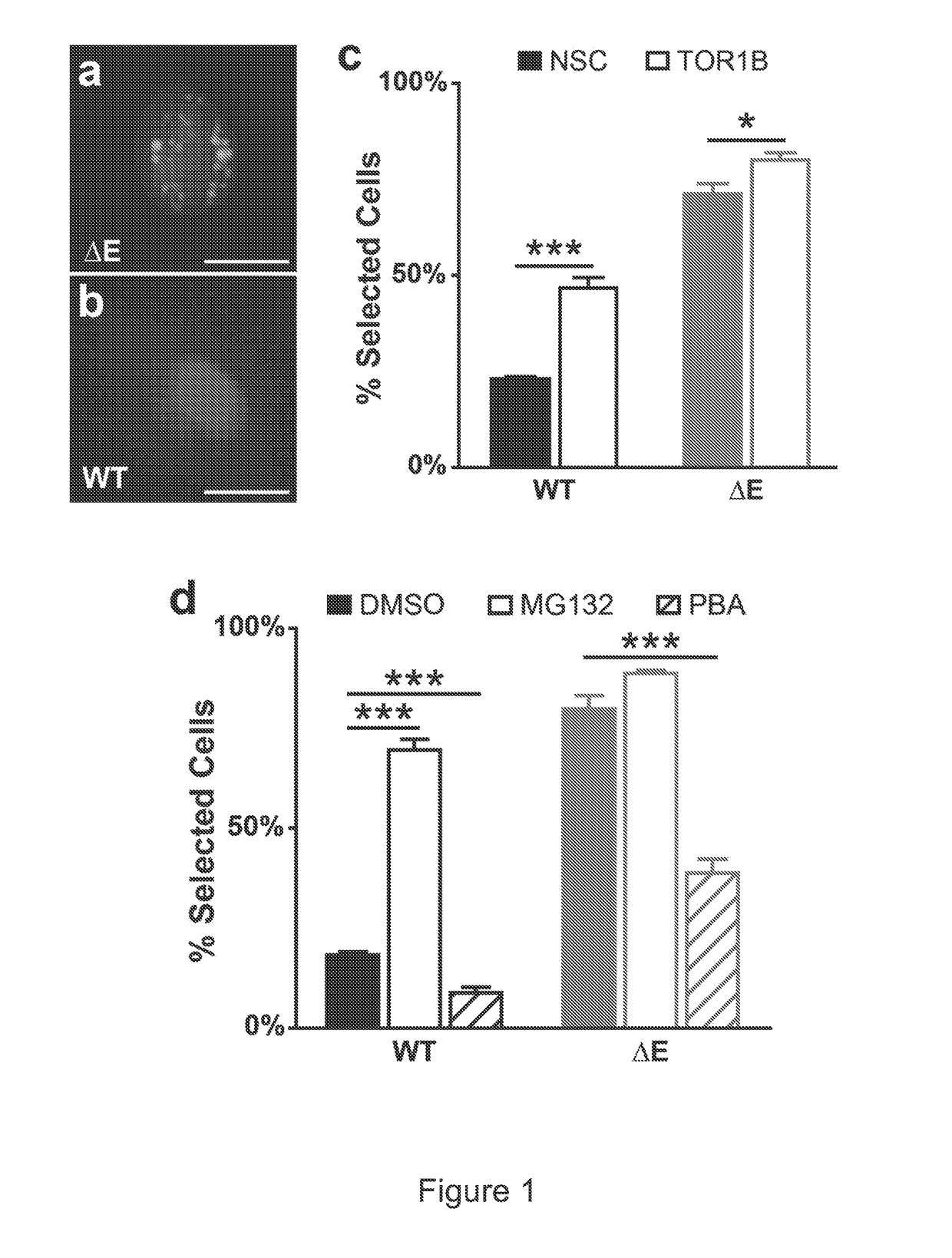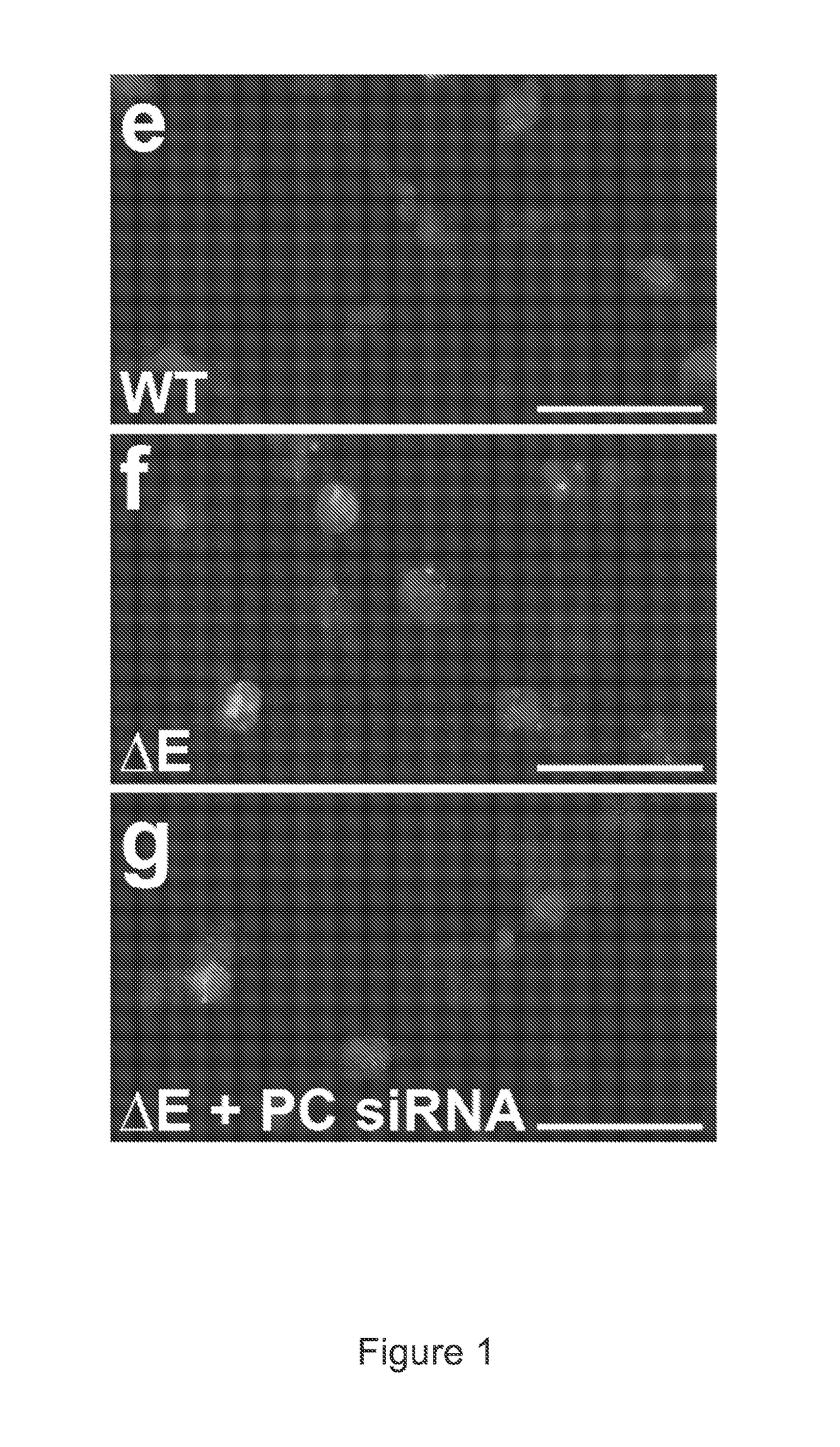Compositions and Methods for Identifying and Treating Dystonia Disorders
a dystonia and disorder technology, applied in the field of diagnosis, prognosis and treatment of dystonia and related disorders, can solve the problems of substantial impairment and disease burden of quality of life of patients, severe limitation of dystonia therapeutic armamentarium, and patients' motor disability and a marked decrease in quality of li
- Summary
- Abstract
- Description
- Claims
- Application Information
AI Technical Summary
Benefits of technology
Problems solved by technology
Method used
Image
Examples
example 1
Development and Validation of Delta-E Torsin1a Localization Assay
[0164]To develop an assay capable of detecting conditions that correct a dystonia cellular phenotype, two human cell lines were generated that stably expressed EGFP-tagged human wild-type Torsin1A, or delta-E Torsin1a, from a single cDNA copy integrated at a defined genomic site (FIG. 1, panel 1).
[0165]To limit variation in expression levels associated with random integration or transient expression, single copies of either WT or delta-E human TOR1A cDNAs with N-terminal EGFP fusions were inserted at the FRT site in Flp-In™ T-Rex™ 293 cells (Thermo Fisher Scientific #R780-07) via flippase recombinase-mediated cassette exchange according to the manufacturer's recommended protocols. This system includes an inducible expression feature (TetON) that avoids selective pressure for potential toxic effects of chronic expression of mutant proteins (FIG. 1, panel 1).
[0166]Flp-In T-Rex 293 cells inducibly expressing either WT or ...
example 2
ome siRNA Screen to Correct Delta-E Torsin1a Mis-Localization
[0179]We first performed a pilot screen targeting 960 genes from the Qiagen Whole Genome siRNA Knock-Down Library 1.0 to determine the robustness of the assay system under automated high-content imaging, high-throughput screening conditions, and to establish that gene knockdown using siRNA could normalize delta-E Torsin1a distribution (FIG. 1, panels e-g; see also, FIG. 9, panel c). We thereby identified suitable screening conditions and a positive control siRNA pair (e.g., FIG. 1, panel g). WT and delta-E treated with non-silencing siRNA control or with positive control siRNA showed the ability to rescue the delta-E Torsin1a mis-localization phenotype (FIG. 1, panels e-g.) The reproducibility of the assay was established in multiple runs (FIG. 1, panel h).
[0180]The genome-wide RNAi screen on Flp-In T-Rex 293 cells inducibly expressing either WT or delta-E Torsin1a was performed at the Duke University RNAi screening facili...
example 3
ation and Bioinformatics Analysis
[0182]To cross-validate WGS hits in a system that did not rely upon exogenous expression of Torsin1a or a fusion protein, four of the highest-quality hits were tested in an orthogonal counter screen using patient-derived fibroblasts. We tested each shRNA for its ability to rescue a previously described defect in luciferase secretion. Chen, P. et al. (2010) Hum. Mol. Genet. 19, 3502-15; Cao, S. et al. (2010) Dis. Model. Mech. 3, 386-96; Barrows, N. J., et al., (2010) J. Biomol. Screen. 15, 735-47.) DYT1 patient data were obtained from 4 independent patient-derived lines and WT data (black bar) from 3 normal healthy control lines. Each line was tested in 5 independent experiments that included 4 technical replicates each (with the exception of SCD data from 3 independent experiments). Three of the four hits tested also improved this DYT1-related phenotype (FIG. 1, panel k). Bioinformatic analysis was then conducted, which identified eleven significantl...
PUM
| Property | Measurement | Unit |
|---|---|---|
| nuclear size | aaaaa | aaaaa |
| radius | aaaaa | aaaaa |
| concentration | aaaaa | aaaaa |
Abstract
Description
Claims
Application Information
 Login to View More
Login to View More - R&D Engineer
- R&D Manager
- IP Professional
- Industry Leading Data Capabilities
- Powerful AI technology
- Patent DNA Extraction
Browse by: Latest US Patents, China's latest patents, Technical Efficacy Thesaurus, Application Domain, Technology Topic, Popular Technical Reports.
© 2024 PatSnap. All rights reserved.Legal|Privacy policy|Modern Slavery Act Transparency Statement|Sitemap|About US| Contact US: help@patsnap.com










